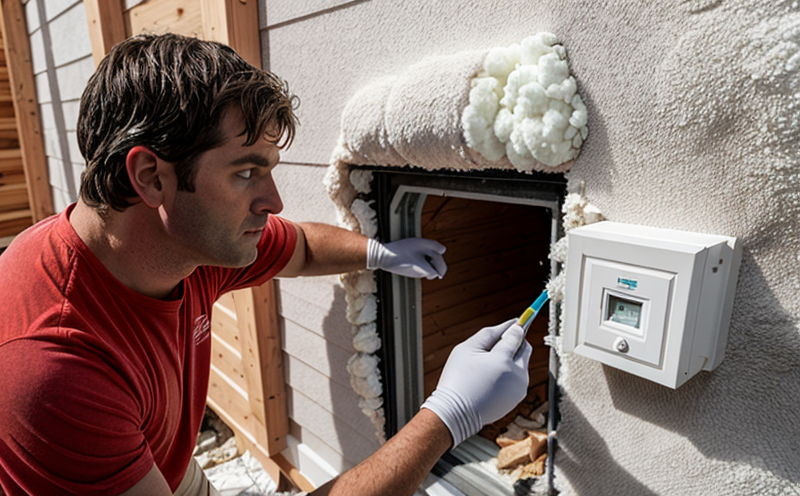ASTM C1114 Thermal Conductivity of Polystyrene Boards
The ASTM C1114 standard provides a method to determine the thermal conductivity of polystyrene boards, which is critical for ensuring that these materials meet design specifications and perform optimally in building insulation applications. This test is particularly important as it helps assess how effectively the material can resist heat flow, thereby contributing to energy efficiency and reducing heating and cooling costs.
Polystyrene foam board is widely used in construction due to its excellent insulating properties. Understanding the thermal conductivity of polystyrene boards ensures that they are chosen appropriately for specific applications. This test measures how easily heat passes through the material, which directly impacts a building's energy performance and comfort levels.
The ASTM C1114 procedure involves placing a specimen between two metal plates, one heated to a specified temperature and the other cooled. The thermal gradient created is measured using thermocouples or resistance temperature detectors (RTDs). By calculating the heat flow through the specimen under controlled conditions, we can accurately determine its thermal conductivity.
Accurate measurement of thermal conductivity is crucial for quality assurance in building construction. It enables architects and engineers to select materials that will perform as expected in various environmental conditions, ensuring compliance with energy codes and standards such as ASHRAE, LEED, and others. The test results are often used during the design phase to optimize insulation performance.
Understanding the thermal conductivity of polystyrene boards also aids in lifecycle cost analysis by predicting long-term operational costs associated with heating and cooling. This knowledge is vital for both new construction projects and existing building retrofits aimed at improving energy efficiency.
The ASTM C1114 test ensures that materials used meet the performance criteria outlined in international standards, providing confidence to stakeholders involved in the design and construction processes. By adhering to these rigorous testing protocols, builders can ensure that their structures are not only compliant with regulatory requirements but also optimized for energy efficiency.
For those responsible for quality assurance, compliance officers, R&D engineers, and procurement professionals, this test offers valuable insights into material performance. It helps in making informed decisions about the best materials to use based on thermal conductivity data, thus contributing significantly towards achieving sustainable building practices.
Why It Matters
The importance of ASTM C1114 cannot be overstated when it comes to ensuring that polystyrene boards meet the necessary performance standards for insulation. This test plays a pivotal role in validating whether these materials will effectively reduce heat transfer through walls, roofs, and floors.
- Ensures compliance with building codes and regulations
- Aids in achieving LEED certification requirements
- Supports lifecycle cost analysis by predicting long-term operational costs
By accurately measuring the thermal conductivity of polystyrene boards, we can ensure that the materials used are capable of maintaining a consistent temperature gradient across their thickness. This is essential for achieving optimal insulation performance and contributing to energy savings.
The test also helps in identifying any potential issues with material quality or consistency early on during production and installation processes. This allows for timely adjustments if necessary, preventing costly rework later down the line. Furthermore, accurate thermal conductivity data contributes significantly towards sustainable building practices by promoting the use of energy-efficient materials.
Applied Standards
| Standard Code | Description |
|---|---|
| ASTM C1114- | Determining the Thermal Conductivity of Polystyrene Boards by Means of Guarded Hot Plate Apparatus. |
| ISO 9792:2015 | Thermal Insulation - Determination of Steady-State Heat Transfer Properties in Thin Specimens (Guarded Hot Plate Method). |
The ASTM C1114 standard specifies the procedure for determining the thermal conductivity of polystyrene boards using a guarded hot plate apparatus. This method involves placing a specimen between two metal plates, one heated to a specified temperature and the other cooled. The thermal gradient created is measured using thermocouples or RTDs.
The ISO 9792 standard provides additional guidance on determining steady-state heat transfer properties in thin specimens, which aligns closely with the ASTM C1114 approach. Both standards aim to provide accurate measurements of thermal conductivity under controlled conditions, ensuring reliable and reproducible results.
Environmental and Sustainability Contributions
- The use of polystyrene boards in construction helps reduce energy consumption by minimizing heat loss or gain through walls, roofs, and floors.
- This reduction in energy usage translates to lower greenhouse gas emissions from power plants, contributing positively to global environmental efforts.
By accurately measuring the thermal conductivity of polystyrene boards according to ASTM C1114, we ensure that these materials perform optimally as insulators. This not only contributes to more energy-efficient buildings but also supports broader sustainability goals by reducing overall carbon footprints associated with heating and cooling.
The results from this testing can be used to inform design decisions regarding the placement of insulation within structures, ensuring maximum effectiveness in terms of heat retention or dissipation depending on the specific needs of a project. Such informed choices play an essential role in promoting sustainable construction practices that benefit both occupants and the environment.





